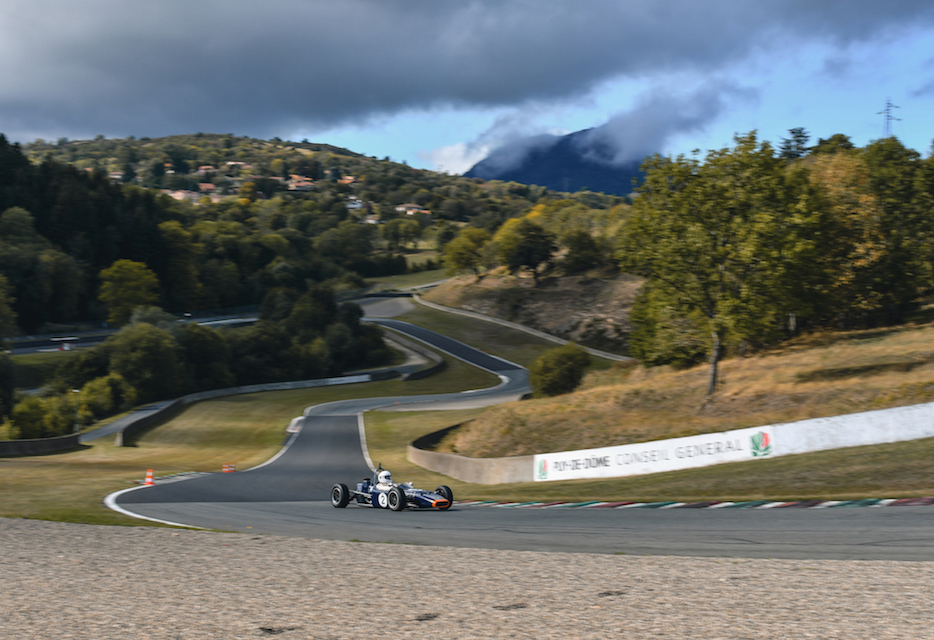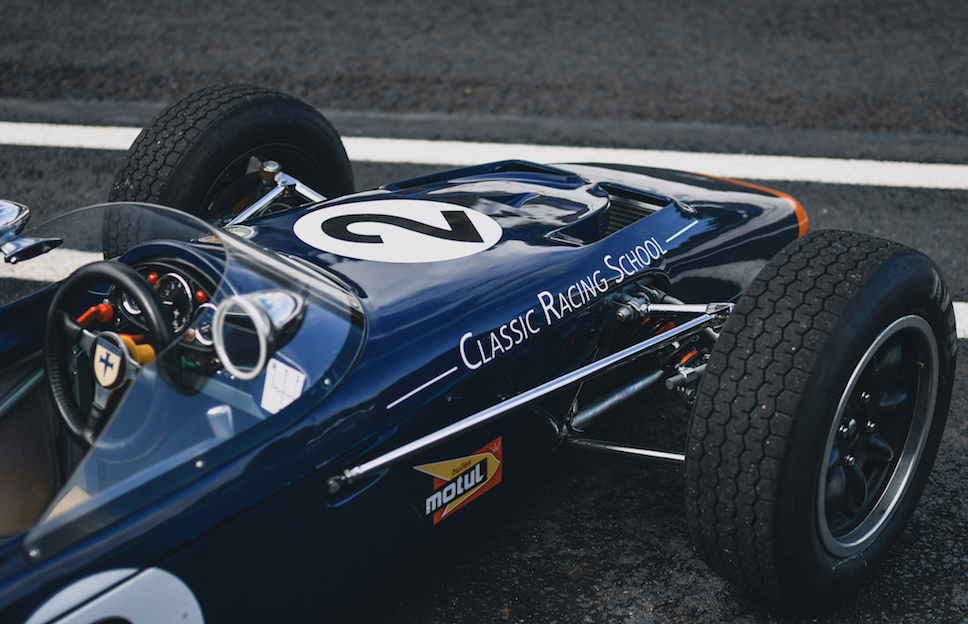Have you ever seen the 1966 John Frankenheimer classic, the "Grand Prix" movie? If not, then you should. This film succeeds in fully portraying the atmosphere of Grand Prix racing at a time when it was a blood sport.
Frankenheimer's picture was innovative for the 1960s, because several real F1 drivers took part in races with cameras attached to their cars, and F3 cars, dressed up as the more powerful Grand Prix vehicles, took part in filming together with a camera-equipped Ford GT40. The breathtaking driving sequences still set this film apart. Much later, the same director made "Ronin", another film famous for its high-speed car sequences.


A racing circuit, located in France near the city of Clermont-Ferrand, was used as a location during the filming of "Grand Prix". The Charade racetrack was created after WWII by joining up twisty roads around the base of Puy de Dôme, an extinct volcano, a symbol of the region of Auvergne. It was considered to be equivalent to the German Nürburgring. There was no room for error: sharp stones at the edges of the track would rip tires open, and there was simply no runoff where a spinning car could lose its momentum. The French Grand Prix was run at Charade in 1965, 1969, 1970 and 1972; Jim Clark, Jackie Stewart and Jochen Rindt won here. It was also a deadly place: Ivor Bueb, the 1955 Le Mans winner, died here, and Helmut Marko, the talented Austrian driver, lost an eye.

In 1988 the circuit was transformed, and less than half of it remained (just under 4 kilometers out of the original 8 km). Twelve years later the public roads which made up the circuit loop were closed to regular traffic, and the racetrack finally became a permanent facility. It is home to Classic Racing Group, a unique company started by two shrewd Frenchmen, enthusiastic about historic racing at its most organic: Morgan Pezzo and Julien Chaffard. They spent their student loans on a 1969 Crosslé 16F race car and on a downpayment at the Northern Irish Crosslé company. I am standing next to them on wet tarmac, facing a colorful line of single-seater racing cars. Everything looks like the set of Frankenheimer's "Grand Prix" and I am back in 1965, for a moment, at least.


Charade is not suitable for people who scare easily. The friction coefficient changes constantly, the surface has many imperfections, there are huge gradients and the runoff areas are the opposite of generous. And the concrete walls. Not energy-absorbing Armco, covered in layers of worn out tires, but unyielding, coarse concrete, dark with age. It looms close to the edge of the track. Very close. Well, realism has its price: driving a classic single-seater is more risky than driving today's Formula One cars. My brain reminds me of that section of Ferdinand Piëch's autobiography which deals with the Porsche 909 hillclimb car, a superlight projectile designed to win at any cost. The drivers knew that any collision would result in the loss of their legs, but Piëch said that this design feature would motivate the racers not to hit anything. Oh well. That's good advice for me then.



I am going to spend a whole day with a modern version of a classic 1960s Formula Ford race car. It looks just like those lethal machines which fill the screen in "Grand Prix". The Crosslé Car Company was created in Northern Ireland in 1957 and it quickly became famous for its popular, well engineered racecars designed for Formula Ford, Formula Junior, American Formula B and C, as well as for the sportscar championship. In the 1970s the little factory in Holywood, County Down (it's still there!) manufactured around 100 cars a year and sold them on both sides of the Atlantic. Thanks to Crosslé cars, drivers such as Nigel Mansell, Eddie Irvine and John Watson were able to display their talent in Formula Ford

The Crosslé 90F, which is the car used at the French racing school at the circuit near Clermont-Ferrand, could easily be confused with the original from over 50 years ago. It differs, however: more modern, more durable materials are used, and the space for the driver has been made larger. It is powered by a 2-liter Ford Zetec engine instead of the prehistoric Kent. You may think that 110 horsepower is not much, but when combined with a traditional 4-speed manual gearbox and only 420 kilograms of weight it guarantees some impressive performance.



Squeezing myself into the cockpit, I try to get my feet used to the pedal placement, my eyes to the instruments and my right arm to the gearchange. And that is immediately a problem: my long arms do not have enough joints. I can easily shift from first to second, but the change into third and later into fourth is proving impossible. After some trial and error I find a way which is sure to cause a lot of bruising, but it is the only one that sort of works: I need to work my right arm out of the cockpit, rotate it and shift while keeping my elbow out of the car and pointing up. With practice it becomes almost smooth, but never natural or comfortable. If I owned such a car I would have to heavily modify the gearchange mechanism.

My training starts with braking practice, on wet tarmac, which I have to perform under the supervision of an old instructor. He helps me improve my technique while simultaneously fixing my French grammar. Once he is satisfied that I have grasped the art of balancing the braking force in such a way as to keep the wheels shod in racing Avons from locking up, he allows me to start driving full laps of the Charade circuit. Instructors place themselves at various points around the track, so my priority is not to crash in front of them. Therefore I am building up speed gradually.



Finding the right rhythm isn't easy. Some corners run steeply uphill or downhill, some of them have a double radius. The car I am driving rewards a smooth driving style and it requires good energy management: the little single-seater is now about outright power, it is about carrying speed through corners. Right after the very challenging Puy de Charade chicane the track runs downhill, the car reaches about 200 km/h, the image in fron of my eyes is vibrating crazily. The view is magnificent, a panorama of extinct volcanoes looming over the car's nose and two rotating wheels. It is simultaneously the most euphoric moment in each lap and the only time the driver can slightly relax. At the bottom of the hill there is a a hairpin with a late braking zone, followed by a sequence of corners which must be memorized. There is a huge grin under my helmet: I am really driving a 1960s race car on the same track which Frankenheimer used for his epic picture. Life rarely gets better.

The next laps are no longer a series of ragged sprints, I make the corners flow into each other and really enjoy the car. Still, several times I delay the braking too much on the still slick surface and even though I recover each time, these are lessons in humility. I am still uncomfortable in the cockpit due to that gearchange problem, but the analog, predictable behavior of the car inspires confidence. Now I know how to balance the car in an awkward, off-camber chicane by gently pushing on the accelerator pedal, counterintuitively, to transfer more weight rearward. If i don't do that, the rear of the little car becomes loose and I see the brownish concrete wall looming in the corner of my eye. When the day at Charade ends, I feel complete: for a few hours I felt like I was playing a part in one of my favorite movies and I learned, to some extent, to control a car designed before I was born. And the most awesome aspect of it all? You can try it yourself. Get in touch with the good people at Charade (www.classicracinggroup.com) and feel like James Garner for a day.
 Images: Benjamin Fournier
Images: Benjamin Fournier




